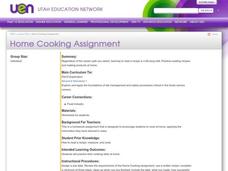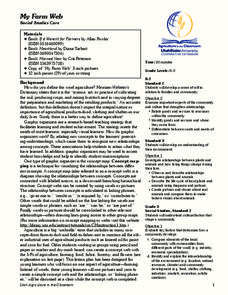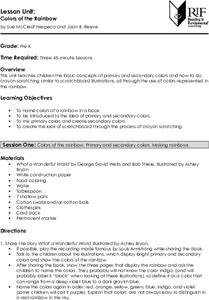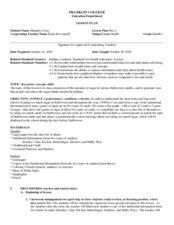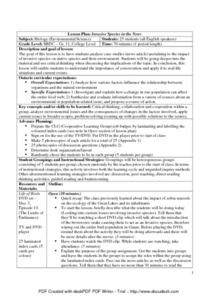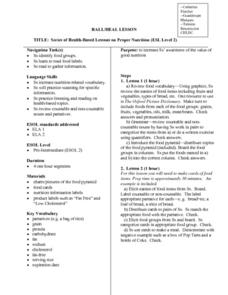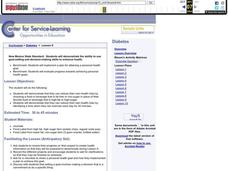Curated OER
Country Project
Students research any part of the United States that they want to know more about. This may include the culture, food or people. They have to present their information to the class, display a visual aid and write a paper on the...
Curated OER
Farm Animals - Mothers and Babies - "Are You My Baby?"
Students listen to a teacher read aloud and discuss the farm animals. They participate in an role playing activity that explains how mother mammals recognize their young by their scent.
Curated OER
Leavening
Students experiment with the various types of leavening agents and complete a muffin lab. They review the basics of lab management and safety procedures: sanitation, measuring, altering recipes, table setting and mealtime manners, basic...
Curated OER
It's a Wrap!
Students read about the importance of packaging foods and related items properly and reducing waste. In this packaging lesson, students read the background information about packaging and bring a variety of packaging materials to class....
Curated OER
Botany: Rice Plant - Second Phase
Third graders make drawings that show the growth of the rice plant in the reproductive phase. For this rice plant lesson plan, 3rd graders read about the second phase of the rice plant, and then draw pictures and label them.
Curated OER
Three Mapping Activities
Students label three maps of China after being introduced to background information about the country. In this geography lesson, students color two maps and label various points of interest in China. Finally, students draw their own...
Curated OER
Home Cooking Assignment
Young scholars practice reading recipes and making products at home. They review the basics of lab management and safety procedures: sanitation, measuring, altering recipes, table setting and mealtime manners, basic utensils and their...
Curated OER
Specializing in Space
In this literature book review activity, young scholars read a nonfiction book about space or space exploration before choosing a topic to explore further. They choose from 7 activities such as designing a model, writing a letter, write...
Curated OER
Dr. Seuss Lesson Plan
Students read classic children's books. For this Dr. Seuss lesson, students read the Seuss classics The Cat in the Hat, Green Eggs & Ham and Horton Hears a Who. Students create models based on story characters and discuss the...
Curated OER
My Farm Web
Students examine the role of agriculture in everyday life. In this agriculture lesson, students read books such as Harvest Year and identify products which from from the farm. Students fill in a word web using the knowledge they gained...
Curated OER
Elements of Design
Students define basic design vocabulary. They examine fabrics and sort into similar piles, design a picture of a beautiful room and label each art element in the design. They read an article from an interior design magazine and summarize...
Curated OER
Colors of the Rainbow
Students explore primary and secondary colors through the use of colors represented in the rainbow. They read and discuss the book, 'What a Wonderful World,' mix paint colors and paint rainbows, and create scratchboard paintings.
Curated OER
Beautiful Bovine
Students compare and contrast a human body to a cow. Using a diagram, they label and identify the functions of the cow's numerous parts. In groups, they create a Venn Diagram to compare the various types of cows with one another. They...
Curated OER
Halloween Candy/ Sugar Content
Fourth graders examine the amount of sugar contained in Halloween candy by looking at nutritional labels from candy bars. They figure out ways to encourage people to reduce the amount of sugar they eat at this holiday. They look at the...
Curated OER
Little Red Hen (Makes a Pizza) Lesson Plan
Students create a pizza recipe based on the recipe used in The Little Red Hen (Makes a Pizza) by Philemon Sturges. For this early childhood lesson plan, students read The Little Red Hen (Makes a Pizza) and identify the ingredients...
Curated OER
Invasive Species in the News
Students explore how invasive species can change an environment. In this critical thinking lesson, students study how invasive animals can change an environments population. They will discuss the implications of an invasive species and...
Curated OER
For Creative Minds
Students study pictures of plants, animals, and minerals. Students classify the pictures into the three groups. In this rock identification lesson, students complete a rock finding lab experiment by finding, cleaning, identifying, and...
Curated OER
Microbe Experimentation
Seventh graders study microorganisms in their environments by experimenting with milk products. For this microbes lesson, 7th graders read background information about microorganisms in yogurt and soured milk. Students then follow a...
Curated OER
Making Molecules
In this molecules worksheet, students combine different food colorings that represent atoms to make different molecules. Students read 7 directions and answer 2 questions.
Curated OER
We All Need Trees
Students complete a guessing game. In this tree products instructional activity, students view various household items and try to determine if they were made from trees. They discuss their findings and then read books about trees.
Curated OER
The Solar System: Why do we Explore?
Third graders act as scientists. In this property discovery lesson, 3rd graders explore the substance "Oobleck" (cornstarch, water, food coloring). They work in groups to investigate the substance and make observations as a scientist...
Curated OER
Celebrate Beef
Students read about the history of cattle, discover new technologies, and fill out worksheets about cattle use. In this cattle lesson plan, students identify states that raise cattle and draw pictures of how cattle is used.
Curated OER
Hall/ Heal Lesson
Students review the food groups and vocabulary in order to define how good nutrition is part of good health. They read a variety of articles in order to better understand the concept and develop reading comprehension at the same time.
Curated OER
DIBETES
Student demonstrates that they can reduce their own health risks by choosing a food or beverage that is fat free or non-sugar in place of their favorite food or beverage that is high-fat or high-sugar. Student identifies a time for...








